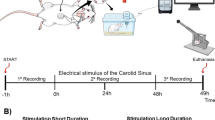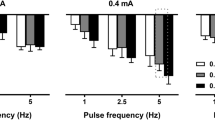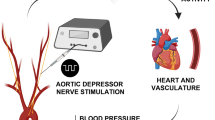Abstract
We evaluated the effects of long-term (48 h) electrical stimulation of the carotid sinus (CS) in hypertensive rats. l-NAME-treated (10 days) Wistar rats were implanted with a catheter in the femoral artery and a miniaturized electrical stimulator attached to electrodes positioned around the left CS, encompassing the CS nerve. One day after implantation, arterial pressure (AP) was directly recorded in conscious animals for 60 min. Square pulses (1 ms, 3 V, 30 Hz) were applied intermittently (20/20 s ON/OFF) to the CS for 48 h. After the end of stimulation, AP was recorded again. Nonstimulated rats (control group) and rats without electrodes around the CS (sham-operated) were also studied. Next, the animals were decapitated, and segments of mesenteric resistance arteries were removed to study vascular function. After the stimulation period, AP was 16 ± 5 mmHg lower in the stimulated group, whereas sham-operated and control rats showed similar AP between the first and second recording periods. Heart rate variability (HRV) evaluated using time and frequency domain tools and a nonlinear approach (symbolic analysis) suggested that hypertensive rats with electrodes around the CS, stimulated or not, exhibited a shift in cardiac sympathovagal balance towards parasympathetic tone. The relaxation response to acetylcholine in endothelium-intact mesenteric arteries was enhanced in rats that underwent CS stimulation for 48 h. In conclusion, long-term CS stimulation is effective in reducing AP levels, improving HRV and increasing mesenteric vascular relaxation in l-NAME hypertensive rats. Moreover, only the presence of electrodes around the CS is effective in eliciting changes in HRV similar to those observed in stimulated rats.
This is a preview of subscription content, access via your institution
Access options
Subscribe to this journal
Receive 12 print issues and online access
$259.00 per year
only $21.58 per issue
Buy this article
- Purchase on Springer Link
- Instant access to full article PDF
Prices may be subject to local taxes which are calculated during checkout




Similar content being viewed by others
References
Bisognano JD, Bakris G, Nadim MK, Sanchez L, Kroon AA, Schafer J, et al. Baroreflex activation therapy lowers blood pressure in patients with resistant hypertension: results from the double-blind, randomized, placebo-controlled rheos pivotal trial. J Am Coll Cardiol. 2011;58:765–73.
Lohmeier TE, Iliescu R. Chronic lowering of blood pressure by carotid baroreflex activation: mechanisms and potential for hypertension therapy. Hypertension. 2011;57:880–6.
Hoppe UC, Brandt MC, Wachter R, Beige J, Rump LC, Kroon AA, et al. Minimally invasive system for baroreflex activation therapy chronically lowers blood pressure with pacemaker-like safety profile: results from the Barostim neo trial. J Am Soc Hypertens. 2012;6:270–6.
Georgakopoulos D, Little WC, Abraham WT, Weaver FA, Zile MR. Chronic baroreflex activation: a potential therapeutic approach to heart failure with preserved ejection fraction. J Card Fail. 2011;17:167–78.
Zannad F, Stough WG, Mahfoud F, Bakris GL, Kjeldsen SE, Kieval RS, et al. Design considerations for clinical trials of autonomic modulation therapies targeting hypertension and heart failure. Hypertension. 2015;65:5–15.
Courand P-Y, Feugier P, Workineh S, Harbaoui B, Bricca G, Lantelme P. Baroreceptor stimulation for resistant hypertension: first implantation in France and literature review. Arch Cardiovasc Dis. 2014;107:690–6.
Griffith LS, Schwartz SI. Reversal of renal hypertension by electrical stimulation of the carotid sinus nerve. Surgery. 1964;56:232–9.
Navaneethan SD, Lohmeier TE, Bisognano JD. Baroreflex stimulation: a novel treatment option for resistant hypertension. J Am Soc Hypertens. 2009;3:69–74.
Lohmeier TE, Irwin ED, Rossing MA, Serdar DJ, Kieval RS. Prolonged activation of the baroreflex produces sustained hypotension. Hypertension. 2004;43:306–11.
Lohmeier TE, Barrett AM, Irwin ED. Prolonged activation of the baroreflex: a viable approach for the treatment of hypertension? Curr Hypertens Rep. 2005;7:193–8.
Lohmeier TE, Hildebrandt DA, Dwyer TM, Barrett AM, Irwin ED, Rossing MA, et al. Renal denervation does not abolish sustained baroreflex-mediated reductions in arterial pressure. Hypertension. 2007;49:373–9.
Parsonnet V, Rothfeld EL, Raman KV, Myers GH. Electrical stimulation of the carotid sinus nerve. Surg Clin North Am. 1969;49:589–96.
Illig KA, Levy M, Sanchez L, Trachiotis GD, Shanley C, Irwin E, et al. An implantable carotid sinus stimulator for drug-resistant hypertension: surgical technique and short-term outcome from the multicenter phase II Rheos feasibility trial. J Vasc Surg. 2006;44:1213–8.
Filippone JD, Bisognano JD. Baroreflex stimulation in the treatment of hypertension. Curr Opin Nephrol Hypertens. 2007;16:403–8.
Scheffers IJ, Kroon AA, Schmidli J, Jordan J, Tordoir JJ, Mohaupt MG, et al. Novel baroreflex activation therapy in resistant hypertension: results of a European multi-center feasibility study. J Am Coll Cardiol. 2010;56:1254–8.
Gassler JP, Lynch PS, Bisognano JD. The role of baroreflex activation therapy in sympathetic modulation for the treatment of resistant hypertension. Heart. 2012;98:1689–92.
Alnima T, de Leeuw PW, Tan FE, Kroon AA. Rheos Pivotal Trial, Investigators. Renal responses to long-term carotid baroreflex activation therapy in patients with drug-resistant hypertension. Hypertension. 2013;61:1334–9.
Su D-F, Miao C-Y. Reduction of blood pressure variability: a new strategy for the treatment of hypertension. Trends Pharm Sci. 2005;26:388–90.
Thayer JF, Lane RD. The role of vagal function in the risk for cardiovascular disease and mortality. Biol Psychol. 2007;74:224–42.
Katayama PL, Castania JA, Dias DP, Patel KP, Fazan R Jr, Salgado HC. Role of chemoreceptor activation in hemodynamic responses to electrical stimulation of the carotid sinus in conscious rats. Hypertension. 2015;66:598–603.
Santos-Almeida FM, Domingos-Souza G, Meschiari CA, Favaro LC, Becari C, Castania JA, et al. Carotid sinus nerve electrical stimulation in conscious rats attenuates systemic inflammation via chemoreceptor activation. Sci Rep. 2017;7:6265.
Ribeiro MO, Antunes E, de Nucci G, Lovisolo SM, Zatz R. Chronic inhibition of nitric oxide synthesis. A new model of arterial hypertension. Hypertension. 1992;20:298–303.
Zatz R, Baylis C. Chronic nitric oxide inhibition model six years on. Hypertension. 1998;32:958–64.
Dos Santos FM, Martins Dias DP, da Silva CA, Fazan R Jr, Salgado HC. Sympathetic activity is not increased in L-NAME hypertensive rats. Am J Physiol Regul Integr Comp Physiol. 2010;298:R89–95.
Scrogin KE, Veelken R, Luft FC. Sympathetic baroreceptor responses after chronic NG-nitro-L-arginine methyl ester treatment in conscious rats. Hypertension. 1994;23:982–6.
Qadri F, Carretero OA, Scicli AG. Centrally produced neuronal nitric oxide in the control of baroreceptor reflex sensitivity and blood pressure in normotensive and spontaneously hypertensive rats. Jpn J Pharm. 1999;81:279–85.
Margatho LO, Porcari CY, Macchione AF, da Silva Souza GD, Caeiro XE, Antunes-Rodrigues J, et al. Temporal dissociation between sodium depletion and sodium appetite appearance: involvement of inhibitory and stimulatory signals. Neuroscience. 2015;297:78–88.
Domingos-Souza G, Meschiari CA, Buzelle SL, Callera JC, Antunes-Rodrigues J. Sodium and water intake are not affected by GABAC receptor activation in the lateral parabrachial nucleus of sodium-depleted rats. J Chem Neuroanat. 2016;74:47–54.
Duque JJ, Silva LE, Murta LO. Open architecture software platform for biomedical signal analysis. Conf Proc IEEE Eng Med Biol Soc. 2013;2013:2084–7.
Montano N, Ruscone TG, Porta A, Lombardi F, Pagani M, Malliani A. Power spectrum analysis of heart rate variability to assess the changes in sympathovagal balance during graded orthostatic tilt. Circulation. 1994;90:1826–31.
Porta A, Guzzetti S, Montano N, Furlan R, Pagani M, Malliani A, et al. Entropy, entropy rate, and pattern classification as tools to typify complexity in short heart period variability series. IEEE Trans Biomed Eng. 2001;48:1282–91.
Guzzetti. Symbolic dynamics of heart rate variability: a probe to investigate cardiac autonomic modulation (vol 112, pg 465, 2005). Circulation. 2005;112:E122–E122.
Kollai M, Koizumi K. Reciprocal and non-reciprocal action of the vagal and sympathetic nerves innervating the heart. J Auton Nerv Syst. 1979;1:33–52.
Mulvany MJ, Halpern W. Contractile properties of small arterial resistance vessels in spontaneously hypertensive and normotensive rats. Circ Res. 1977;41:19–26.
Joannides R, Haefeli WE, Linder L, Richard V, Bakkali EH, Thuillez C, et al. Nitric oxide is responsible for flow-dependent dilatation of human peripheral conduit arteries in vivo. Circulation. 1995;91:1314–9.
da Silva CG, Specht A, Wegiel B, Ferran C, Kaczmarek E. Mechanism of purinergic activation of endothelial nitric oxide synthase in endothelial cells. Circulation. 2009;119:871–9.
Lohmeier TE, Iliescu R, Dwyer TM, Irwin ED, Cates AW, Rossing MA. Sustained suppression of sympathetic activity and arterial pressure during chronic activation of the carotid baroreflex. Am J Physiol Heart Circ Physiol. 2010;299:H402–9.
Hildebrandt DA, Irwin ED, Cates AW, Lohmeier TE. Regulation of renin secretion and arterial pressure during prolonged baroreflex activation: influence of salt intake. Hypertension. 2014;64:604–9.
Wustmann K, Kucera JP, Scheffers I, Mohaupt M, Kroon AA, de Leeuw PW, et al. Effects of chronic baroreceptor stimulation on the autonomic cardiovascular regulation in patients with drug-resistant arterial hypertension. Hypertension. 2009;54:530–6.
Castania JA, Katayama PL, Brognara F, Moraes DJA, Sabino JPJ, Salgado HC. Selective denervation of the aortic and carotid baroreceptors in rats. Exp Physiol. 2019;104:1335–42.
Bloch MJ, Basile JN. The Rheos Pivotol trial evaluating baroreflex activation therapy fails to meet efficacy and safety end points in resistant hypertension: back to the drawing board. J Clin Hypertens. 2012;14:184–6.
Heusser K, Tank J, Luft FC, Jordan J. Baroreflex failure. Hypertension. 2005;45:834–9.
Porta A, Tobaldini E, Guzzetti S, Furlan R, Montano N, Gnecchi-Ruscone T. Assessment of cardiac autonomic modulation during graded head-up tilt by symbolic analysis of heart rate variability. Am J Physiol-Heart Circulatory Physiol. 2007;293:H702–8.
Heusser K, Tank J, Engeli S, Diedrich A, Menne J, Eckert S, et al. Carotid baroreceptor stimulation, sympathetic activity, baroreflex function, and blood pressure in hypertensive patients. Hypertension. 2010;55:619–26.
Mancia G, Grassi G. The autonomic nervous system and hypertension. Circ Res. 2014;114:1804–14.
Tucker DC, Johnson AK. Development of autonomic control of heart rate in genetically hypertensive and normotensive rats. Am J Physiol. 1984;246:R570–7.
McCarty R, Kirby RF, Cierpial MA, Jenal TJ. Accelerated development of cardiac sympathetic responses in spontaneously hypertensive (SHR) rats. Behav Neural Biol. 1987;48:321–33.
Huston JM, Gallowitsch-Puerta M, Ochani M, Ochani K, Yuan R, Rosas-Ballina M, et al. Transcutaneous vagus nerve stimulation reduces serum high mobility group box 1 levels and improves survival in murine sepsis. Crit Care Med. 2007;35:2762–8.
Gierthmuehlen M, Plachta DT. Effect of selective vagal nerve stimulation on blood pressure, heart rate and respiratory rate in rats under metoprolol medication. Hypertens Res. 2016;39:79–87.
Kang K-T. Endothelium-derived relaxing factors of small resistance arteries in hypertension. Toxicological Res. 2014;30:141–8.
Paulis L, Zicha J, Kunes J, Hojna S, Behuliak M, Celec P, et al. Regression of L-NAME-induced hypertension: the role of nitric oxide and endothelium-derived constricting factor. Hypertens Res. 2008;31:793–803.
Jiang J, Zheng J-P, Li Y, Gan Z, Jiang Y, Huang D, et al. Differential contribution of endothelium-derived relaxing factors to vascular reactivity in conduit and resistance arteries from normotensive and hypertensive rats. Clin Exp Hypertens. 2016;38:393–8.
Garland CJ, Hiley CR, Dora KA. EDHF: spreading the influence of the endothelium. Br J Pharm. 2011;164:839–52.
Iwama Y, Kato T, Muramatsu M, Asano H, Shimizu K, Toki Y, et al. Correlation with blood pressure of the acetylcholine-induced endothelium-derived contracting factor in the rat aorta. Hypertension. 1992;19:326–32.
Gardiner SM, Compton AM, Bennett T, Palmer RM, Moncada S. Control of regional blood flow by endothelium-derived nitric oxide. Hypertension. 1990;15:486–92.
Sander M, Hansen J, Victor RG. The sympathetic nervous system is involved in the maintenance but not initiation of the hypertension induced by N(omega)-nitro-L-arginine methyl ester. Hypertension. 1997;30:64–70.
Biancardi VC, Bergamaschi CT, Lopes OU, Campos RR. Sympathetic activation in rats with L-NAME-induced hypertension. Braz J Med Biol Res. 2007;40:401–8.
Rees DD, Palmer RM, Schulz R, Hodson HF, Moncada S. Characterization of three inhibitors of endothelial nitric oxide synthase in vitro and in vivo. Br J Pharm. 1990;101:746–52.
Wilson C, Lee MD, McCarron JG. Acetylcholine released by endothelial cells facilitates flow-mediated dilatation. J Physiol. 2016;594:7267–307.
Ghosh S, Gupta M, Xu W, Mavrakis DA, Janocha AJ, Comhair SA, et al. Phosphorylation inactivation of endothelial nitric oxide synthesis in pulmonary arterial hypertension. Am J Physiol Lung Cell Mol Physiol. 2016;310:L1199–205.
Harris MB, Ju H, Venema VJ, Liang H, Zou R, Michell BJ, et al. Reciprocal phosphorylation and regulation of endothelial nitric-oxide synthase in response to bradykinin stimulation. J Biol Chem. 2001;276:16587–91.
Chen CA, Druhan LJ, Varadharaj S, Chen YR, Zweier JL. Phosphorylation of endothelial nitric-oxide synthase regulates superoxide generation from the enzyme. J Biol Chem. 2008;283:27038–47.
Chen F, Kumar S, Yu Y, Aggarwal S, Gross C, Wang Y, et al. PKC-dependent phosphorylation of eNOS at T495 regulates eNOS coupling and endothelial barrier function in response to G+ -toxins. PLoS ONE. 2014;9:e99823.
Financial support
FAPESP (Fundação de Amparo à Pesquisa do Estado de São Paulo).
Author information
Authors and Affiliations
Corresponding author
Ethics declarations
Conflict of interest
The authors declare that they have no conflict of interest.
Additional information
Publisher’s note Springer Nature remains neutral with regard to jurisdictional claims in published maps and institutional affiliations.
Rights and permissions
About this article
Cite this article
Domingos-Souza, G., Santos-Almeida, F.M., Meschiari, C.A. et al. Electrical stimulation of the carotid sinus lowers arterial pressure and improves heart rate variability in l-NAME hypertensive conscious rats. Hypertens Res 43, 1057–1067 (2020). https://doi.org/10.1038/s41440-020-0448-7
Received:
Revised:
Accepted:
Published:
Issue Date:
DOI: https://doi.org/10.1038/s41440-020-0448-7
Keywords
This article is cited by
-
The ability of baroreflex activation to improve blood pressure and resistance vessel function in spontaneously hypertensive rats is dependent on stimulation parameters
Hypertension Research (2021)
-
Electrical carotid sinus stimulation may get lost in translation
Hypertension Research (2020)



